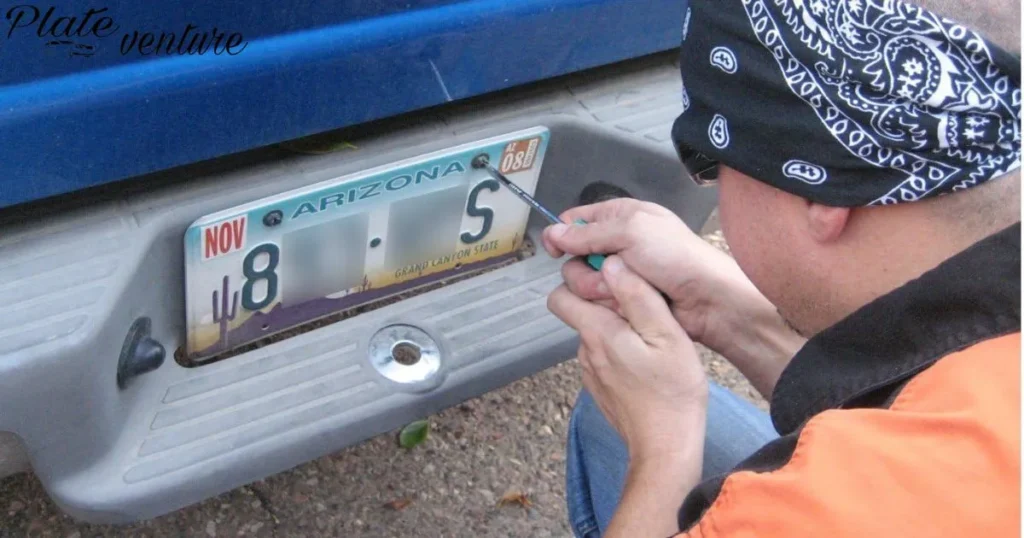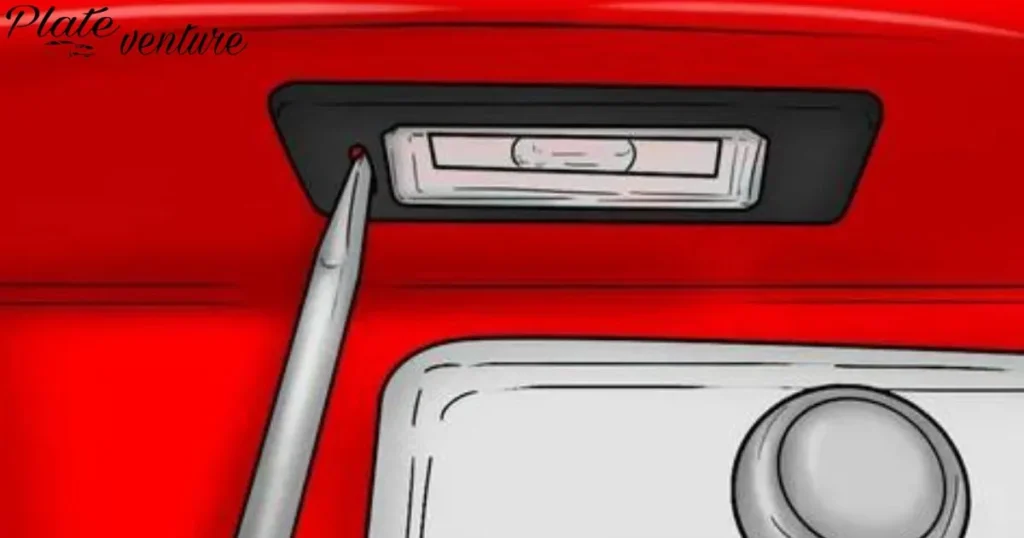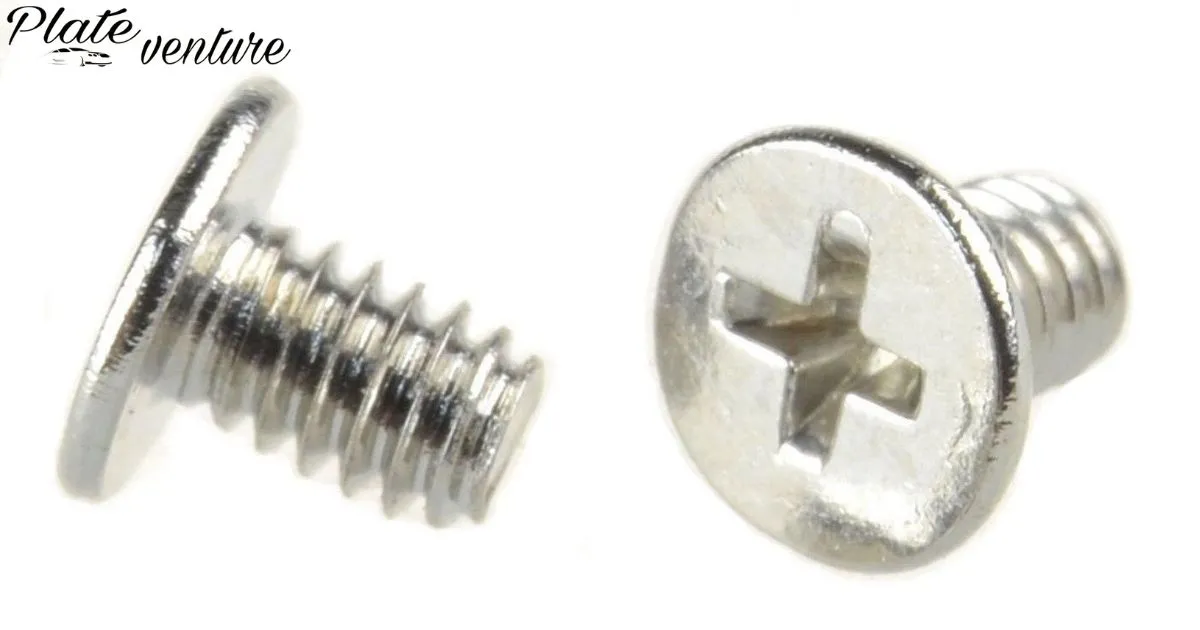The size of license plate screws refers to the dimensions of the screws used to secure a vehicle’s license plate. These screws are typically standardized to ensure compatibility with the license plate holes and the vehicle’s mounting area. The size usually includes the diameter and length of the screw, often measured in millimeters or inches.
What Is The Size Of License Plate Screws? This question might seem trivial, but it’s actually quite important. Whether you’re replacing a lost screw or installing a new license plate, knowing the correct size can save you time and frustration. It’s a small detail that can make a big difference in your vehicle maintenance tasks.
License plate screws typically come in a few standard sizes. In the United States, for example, the most common sizes are #14 and #12, with lengths varying from 1/2 inch to 3/4 inch. However, the size can vary depending on the make and model of the vehicle, and the specific requirements of the license plate or frame. It’s always best to check your vehicle’s manual or consult with a professional to ensure you have the correct size.
Understanding License Plate Hardware
License plate hardware refers to the various components used to securely attach a license plate to a vehicle. This typically includes screws or bolts, and may also involve a frame, spacers, washers, and screw covers.
The hardware must be durable to withstand the elements and prevent rusting, and it should be compatible with the vehicle’s design. Some hardware kits offer tamper-proof features to deter theft, using specialized screws that require matching tools to remove.
Importance Of Correct Screw Size
Using the correct screw size for license plate mounting is crucial to ensure that the plate is securely attached to the vehicle. Incorrect screw sizes can lead to a loose fit, which may result in rattling, potential loss of the plate while driving, or damage to the vehicle’s bodywork.
Using screws that are too long can penetrate and damage internal components behind the plate mount, while too short screws may not engage properly with the mounting surface.
Standard Sizes For License Plate Screws
There is no universal standard size for license plate screws as different vehicle makes and models may require different sizes. However, a common size found in many vehicles is 1/4″ in diameter by 3/4″ in length.
For example, Dodge vehicles typically use a standard screw size of 1/4″ x 3/4″ with a 3/8″ slotted hex head. It’s important to check the specific requirements for your vehicle, as using the correct size ensures a proper fit and avoids damage to the vehicle or the license plate.
Screw Size Affects License Plate Security
The size of the screw plays a significant role in the security of a license plate. Screws that are too small may not hold the plate firmly in place, making it easier for thieves to remove the plate.
Conversely, screws that are too large may not fit into the designated holes or could damage the threads, compromising the mount’s integrity. Tamper-proof screws, which come in specific sizes, can enhance security by requiring specialized tools for removal, thus deterring theft and unauthorized removal of the plate.
Determining The Size Of Your License Plate Screws
Determining the correct size of your license plate screws is essential for securely attaching your license plate to your vehicle. The size of a license plate screw is typically defined by its diameter, length, and thread pitch.
The most common size for license plate screws is 1/4-14-3/4, where 1/4″ refers to the threaded diameter in inches, 14 represents the number of threads per inch, and 3/4″ indicates the screw’s length. However, sizes can vary, and it’s important to know whether your vehicle requires metric or standard screws, as metric screws are slightly longer and have a smaller diameter than standard screws2.
Measuring License Plate Screws

To accurately measure license plate screws, you’ll need to determine three key dimensions: length, diameter, and thread pitch. Length is the easiest to measure, while diameter and thread pitch require more specific tools. A caliper is used to measure the diameter of a screw by placing the screw on the bottom jaw of the caliper. To measure the thread pitch, a thread gauge is necessary. By accurately measuring these dimensions, you can ensure you select the correct screw size for your license plate2.
Tools Needed For License Plate Screw Measurement
The essential tools for measuring license plate screws include a caliper and a thread gauge. The caliper is used to measure the screw’s diameter by placing the screw between its jaws.
A thread gauge, on the other hand, is necessary to determine the thread pitch, which is the distance between the threads. These tools are crucial for accurately determining the size of the screws needed to securely attach a license plate to a vehicle.
The Role Of Vehicle Make And Model
The make and model of your vehicle play a significant role in determining the size of the license plate screws required. Different manufacturers may use different sizes and types of screws, ranging from fine thread Phillips head screws to coarse thread hex head bolts.
It’s important to consult your vehicle’s owner’s manual or a dealership for specific information regarding the correct screw size. Knowing whether your vehicle uses metric or standard sizing is also crucial for selecting the appropriate screws24.
Seek Professional Help
If you’re unsure about the correct size of license plate screws for your vehicle or if you encounter difficulties in measuring or finding the appropriate screws, it may be wise to seek professional help.
Automotive professionals, such as mechanics or dealership service departments, have the expertise and tools necessary to determine the correct screw size and can provide or install the screws for you. Seeking professional assistance ensures that your license plate is securely attached and complies with legal requirements2
Common Types Of License Plate Screws
License plate screws come in two primary measurement systems: metric and standard. The type of vehicle often dictates which measurement system is used, with vehicles manufactured in the United States typically using the imperial system. There are also various categories of screws, such as Original Equipment Manufacturer (OEM) screws, which are vehicle-specific, SlimLine screws with minimal head visibility, and Sport line screws with larger heads for bumper attachment without plastic covers12.
Materials Used In License Plate Screws
License plate screws are commonly made from materials like steel, aluminum, or metal alloys. To prevent rust and corrosion, which can be a significant issue for metal components exposed to the elements, these screws are often plated with rust-proof coatings such as black zinc. This plating enhances their resistance to corrosive elements, ensuring longevity and maintaining the aesthetic appeal of the license plate.
Head Types Of License Plate Screws
The head types of license plate screws vary to accommodate different vehicle designs and aesthetic preferences. Some common types include the SlimLine screws, which are designed to be discreet, and the Sport line screws, which have a larger head suitable for vehicles without plastic bumper covers.
Traditional screw heads, like the Shadow line screws, are preferred for specific models such as BMWs, indicating that head types are often chosen based on the vehicle brand and model.
Thread Patterns In License Plate Screws
Thread patterns in license plate screws are designed to match the vehicle’s specifications and ensure a secure fit. While specific details on thread patterns are not provided in the search results, it is implied that the screws must be compatible with the vehicle’s built-in metal retainers or other mounting systems. The correct thread pattern is crucial for the screws to hold the license plate firmly in place.
The Impact Of Weather On License Plate Screw Choice
When choosing license plate screws, the impact of weather is a significant consideration. Screws exposed to moisture, salt, and temperature fluctuations can corrode or rust over time.
Selecting screws with a rust-proof finish, such as those plated with black zinc, is essential to prevent rust lines and tarnishing. This ensures that the screws remain durable and functional despite adverse weather conditions.
How To Replace License Plate Screws

Replacing license plate screws is a straightforward process. You’ll need a screwdriver that fits the screws on your license plate. Unscrew the old screws, remove the license plate, then place the new screws through the holes in the license plate and into the corresponding holes on your vehicle. Tighten the screws until the license plate is secure.
Replace Your License Plate Screws
License plate screws should be replaced when they become rusted, stripped, or damaged in any way that prevents them from securely holding the license plate.
If you notice that your license plate is loose or rattling, it may be time to replace the screws. Additionally, if you’re having difficulty removing the screws due to rust or damage, replacement is necessary.
Step-By-Step Guide To Replacing License Plate Screws
step-by-step guide to replacing license plate screws:
- Remove the Old License Plate: Unscrew the old license plate from your car.
- Prepare the New Screws: Gather two 8mm screws, four washers, two low-profile lock nuts, and two screw cap washers.
- Attach the Screws to the License Plate: Put one of the screws through two of the flat washers, then through a screw cap washer. Fit the license plate into the new license plate frame from the back. From the front, put the screw, with the washers and screw cap washer on it, through the hole in the license plate frame and the license plate, and put the lock nut on the screw. Leave slightly loose and repeat for the other hole.
- Attach the License Plate to the Car: Align the license plate evenly inside of the license plate frame and on the car, then tighten. Do not over tighten.
- Put on the Screw Caps: Take four of the screw caps and snap them over the top of the screw cap washers,
| Step | Description |
| 1 | Remove the old license plate |
| 2 | Prepare the new screws |
| 3 | Attach the screws to the license plate |
| 4 | Attach the license plate to the car |
| 5 | Put on the screw caps |
Troubleshooting Common Issues With License Plate Screws
Common issues with license plate screws include rust, stripping, and difficulty in removal. If the screws are rusted, applying a penetrating oil like WD-40 can help loosen them. If the screws are stripped, using a pair of vise grips to grip the head of the screw can aid in removal. If you’re still having trouble, a hand impact driver or a cordless drill may be useful tools to have on hand.
Ensuring A Secure Fit For License Plate Screws
To ensure a secure fit for your license plate screws, make sure to use the correct size screwdriver when installing them. Most license plate screws are No 3 Phillips, so using a No 3 Phillips screwdriver can improve the fit between the tool and screw.
Avoid over tightening the screws, as this can strip them or damage the license plate. The license plate should be secure, but not overly tight.
Frequently Asked Question
What Is The Standard Size For License Plate Screws?
The most common license plate screw size is 1/4-14-3/4. This indicates the screw’s threaded diameter in inches, the number of threads, and the screw’s length in inches respectively.
Are All License Plate Screws The Same Size?
No, there isn’t a standard license plate screw size. While 1/4-14-3/4 is the most common, there are many other specialized types and sizes. The size can also depend on the vehicle’s make and model.
How Can I Determine The Size Of My License Plate Screws?
To determine the size of your license plate screws, you need to measure the length, diameter, and thread pitch. A thread gauge can be used to measure the thread pitch.
Can I Use Any Screw For My License Plate?
While many screws may fit, it’s best to use screws that are specifically designed for license plates. These screws are typically 1/4 x 3/4 inch, which is a standard fit for most makes and models.
Are License Plate Screws Measured In Metric Or Standard Size?
License plate screws can be measured in either metric or standard size. For example, ¼” is a standard measurement (inches), while 16mm is a metric measurement (millimeters). You need to know whether your vehicle uses standard or metric sizing.
Conclusion
Understanding what is the size of license plate screws is crucial for securely attaching your license plate to your vehicle. The most common size is 1/4-14-3/4, but it’s important to note that there isn’t a standard size, and it can vary depending on the vehicle’s make and model.
It’s essential to know whether your vehicle uses metric or standard sizing. The process of determining the correct size involves measuring the length, diameter, and thread pitch of the screw, which requires specific tools like a caliper and a thread gauge. If you’re unsure, it’s always a good idea to seek professional help to ensure the correct size and secure attachment of your license plate.








